Group B of the Women’s World Cup 2019 pitted two nations together with high aspirations as Germany and Spain came head to head in the second fixture of the group stage. Both sides have seen rapid improvements in quality in recent years, finding themselves amongst the dark horses to lift the trophy come mid-July.
In the end, a hard-fought and tactical tie was decided by just one goal, from Sara Däbritz. The midfielder crept in at the far post to pounce on a loose ball in the box after Sandra Paños spilled a headed effort from Alexandra Popp. Spain dominated for much of the tie, enjoying 64% possession, but in the end, could not do enough to earn an equaliser.
This tactical analysis will consider how Germany managed to null the threat from Spain, regardless of all of their time on the ball, as well as how they overcame their rivals. The result puts Germany in pole position to reach the knock-out stages, potentially even securing qualification should South Africa fail to beat China on Thursday evening, whilst Spain will have it all to play for against China in their final group stage fixture.
Line-Ups
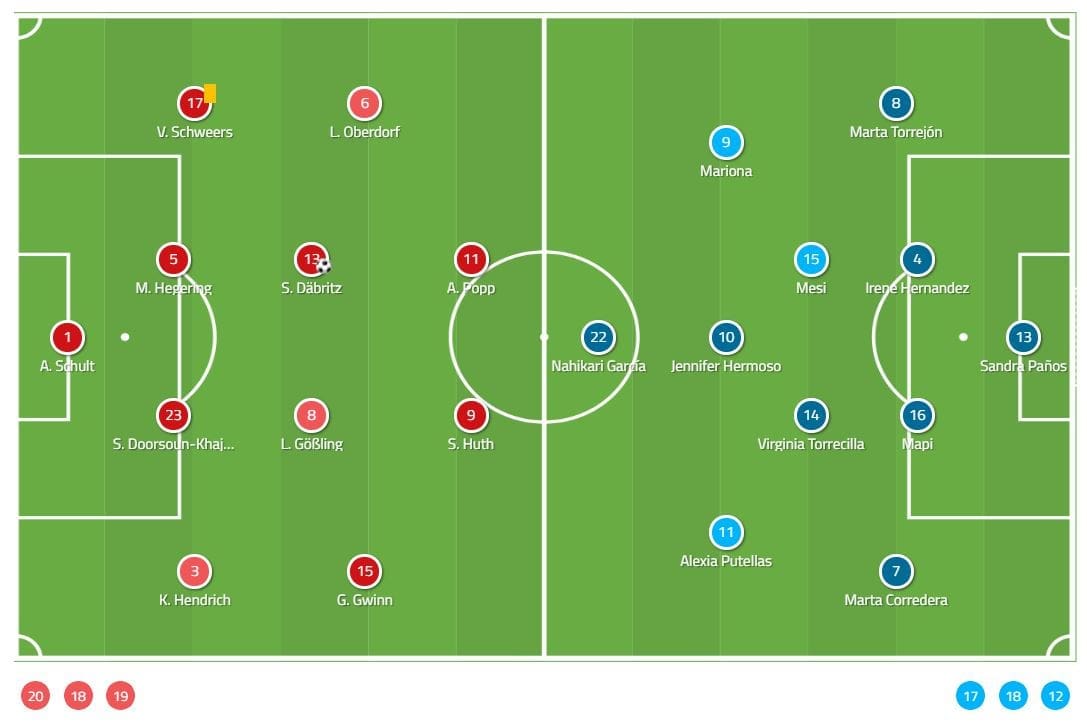
Whereas Germany had lined-up with a 4-5-1 shape against China, they looked to go more offensive against Spain with a 4-4-2. Svenja Huth moved into a more advanced role, joining Popp in attack. It was an intriguing approach, clearly aimed at pinning back the Spanish defence and looking to limit the impact of their full-backs, fighting fire with fire.
Spain, on the other hand, kept their shape, albeit with some intriguing selection decisions. Jenni Hermoso was dropped into a number 10 style playmaker role, meaning that whilst many labelled it the traditional 4-3-3, it could eventually become a 4-2-3-1 in the defensive phase or even a 4-2-4 in the attacking phase.
The German press worked
In the first half in particular, Germany looked to press high. With a measured reaction, they would wait until Spain’s defence looked to move the ball forward before engaging the press, preferring not to commit players forward unless it was absolutely crucial. They instead preferred to stick to their structure, with the two forwards doing the pressing.
One element which proved to be decisive was the way in which Germany would press for potential mistakes whilst in possession. Looking to get crosses and passes into the box, the Germans were always ready to pounce and be the first to get to a rebound. That was in stark contrast to the Spanish defence, which struggled to boast the same anticipation.
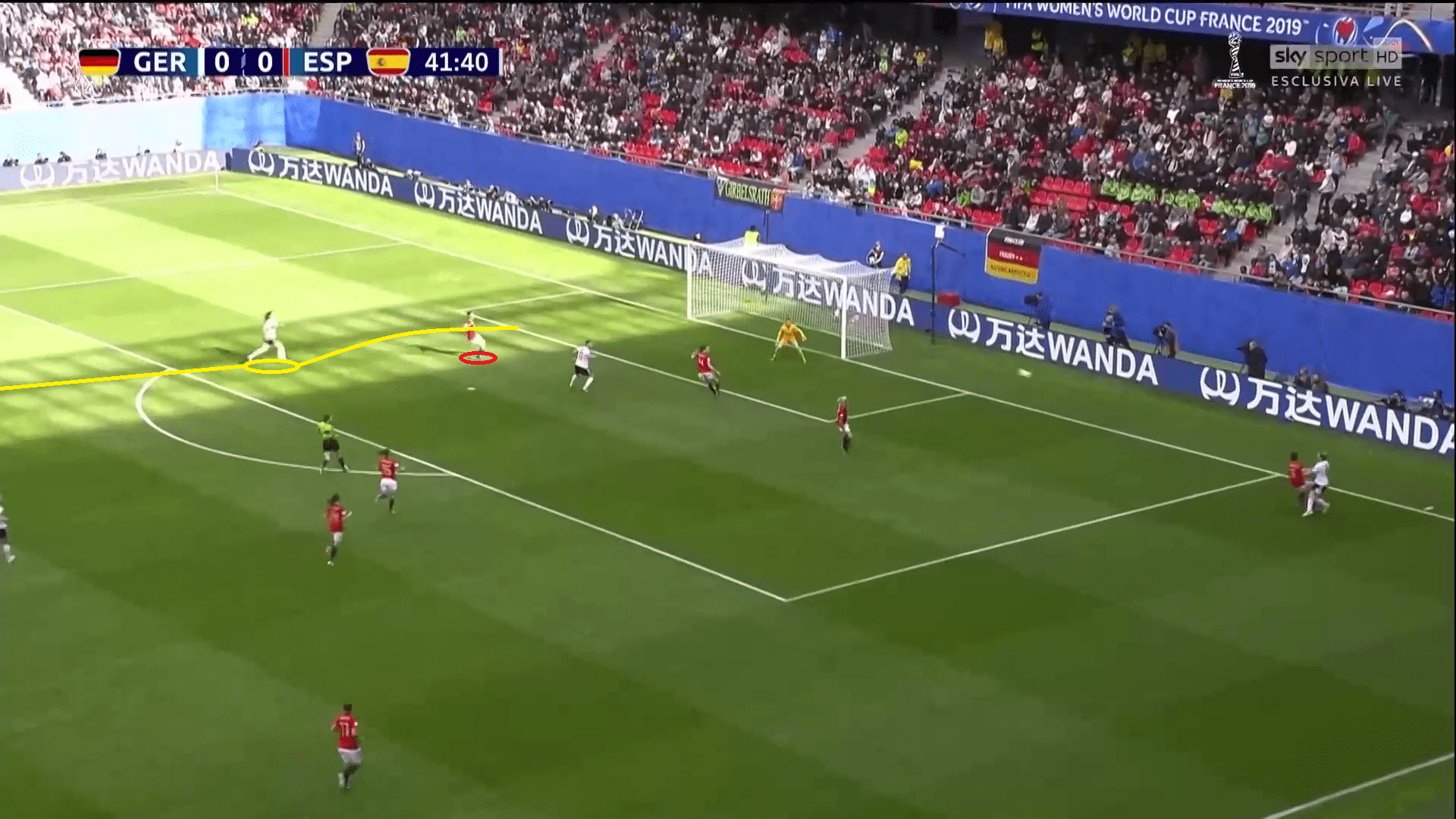
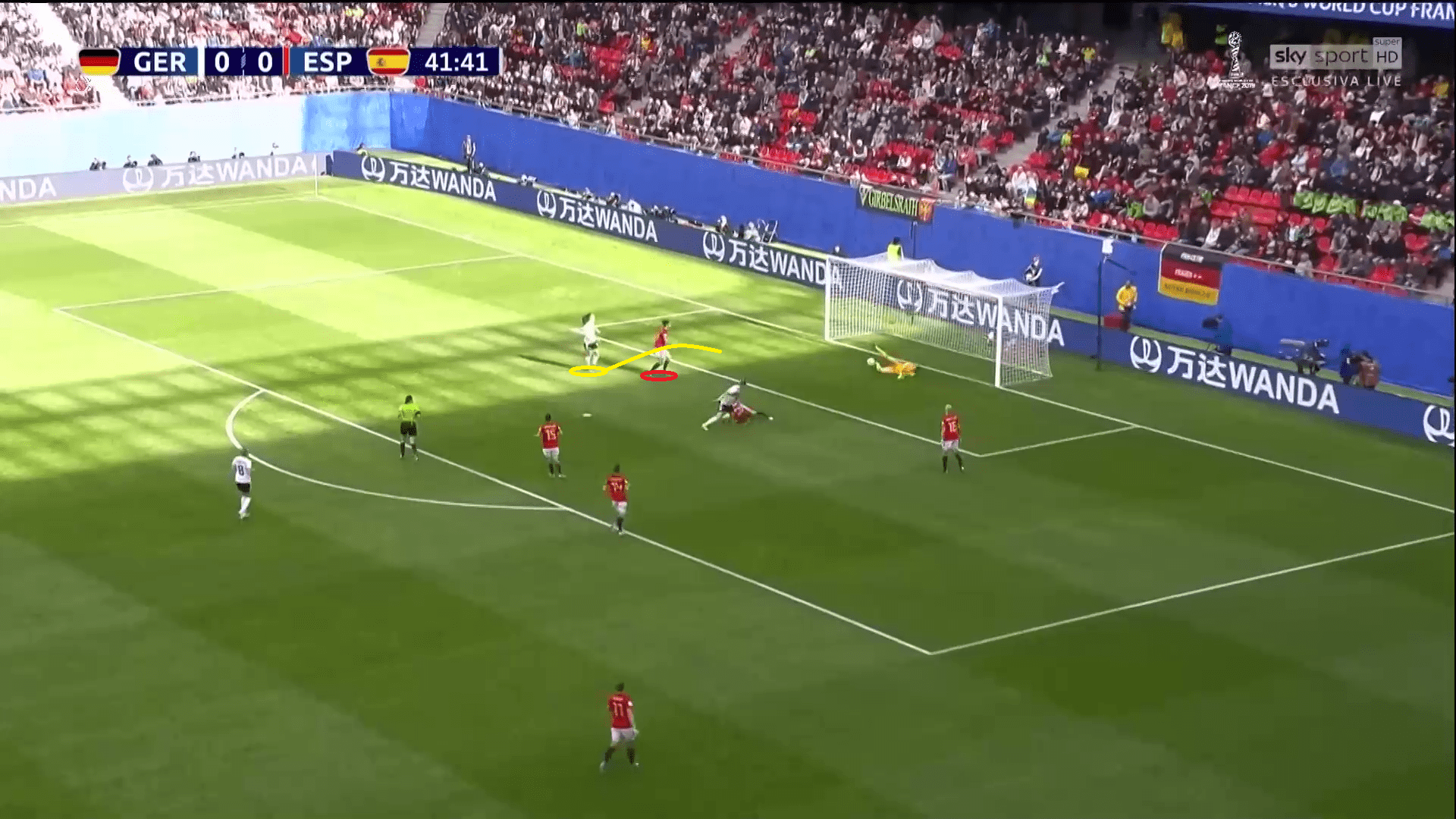
Intriguingly, the press, in general, was more disciplined for the Germany team than it was up against China only a few days ago. There, the press was more powerful, with more players and higher up, but against Spain, this was not the case. Perhaps expecting Spain to be happy to retain possession with sideways passing, Germany were happy to entertain it, waiting for the right moment to press as soon as a forward passing option opened up.
Whilst the Spanish press didn’t
Spain’s press was in some ways more organised, actively looking to push high into the opposition half when out of possession. Even in the first minute, the Spanish front line of three attackers were almost one-to-one with the German defence. However, they were too often guilty of committing too many players forward into the final third.
The below example, just 17 minutes in and with the scoreline still at 0-0 showed the perfect example. The high press forced Germany’s midfield into a small area, which was executed well. That should have allowed one, or at most two, Spanish midfielders to support the press from the two more advanced players, with one sitting deeper to react should the ball break loose or Germany escape on the counter. Instead, all three Spanish midfielders joined the press, effectively dedicating five players to the press. When Germany broke loose, they found themselves on the counter with one player on the ball and three forwards making runs up against four Spanish defenders.
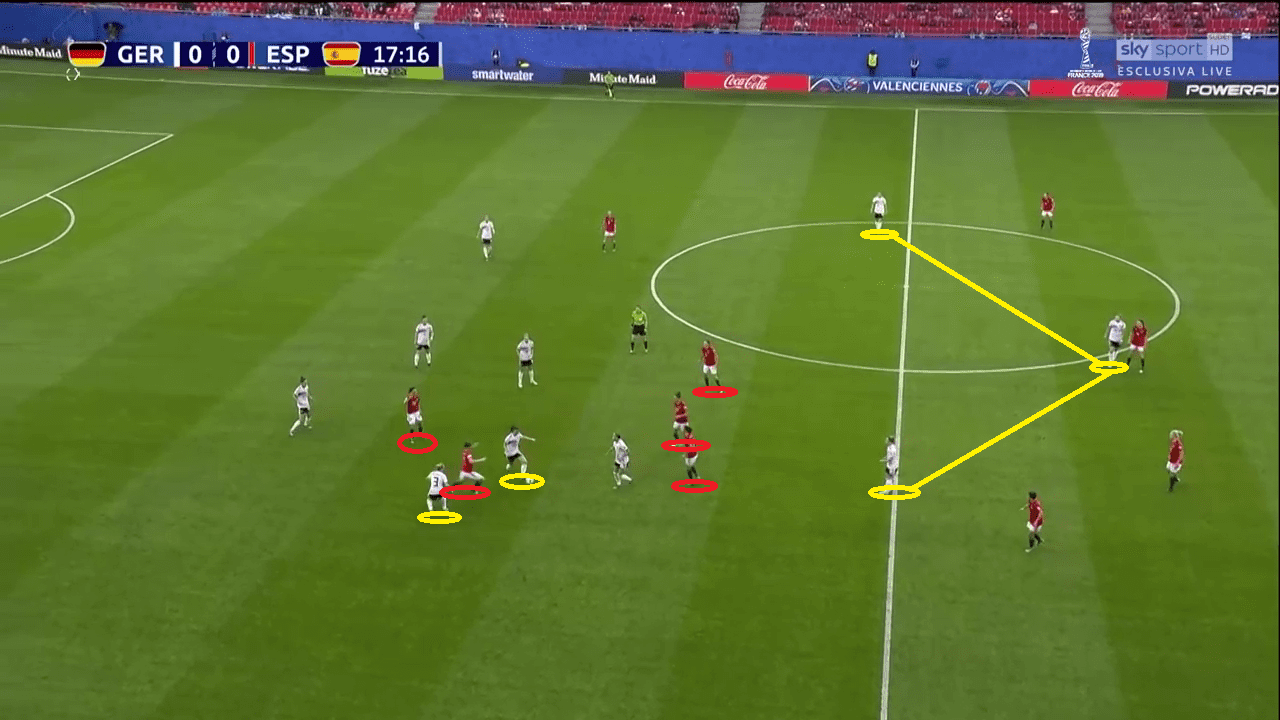
It was not the only time that this happened, though Germany dedicated fewer players to the more advanced positions later on in the game. Showing such vulnerability unnecessarily in such a crucial game was a poor mistake to make for Spain, and did them no favours in events such as the goal where the quick counter-attack down the wing left them without support from midfield to track the late runners, such as Däbritz.
Tiki-taka at its worst
Much like the men’s team in last summer’s World Cup, Spain were on the wrong end of a result despite having significantly more possession. Boasting 64%, at no point dropping below 52% for a five-minute spell, it was clear that Spain had the ball in their court and just couldn’t find their way through.
In total, Spain made 195 passes more than Germany, yet only 35 more passes forward. In comparison, they made 105 lateral passes more than their German counterparts. It reflected the way in which the off-the-ball movement of the Spanish squad struggled to find a way through the structured German lines.
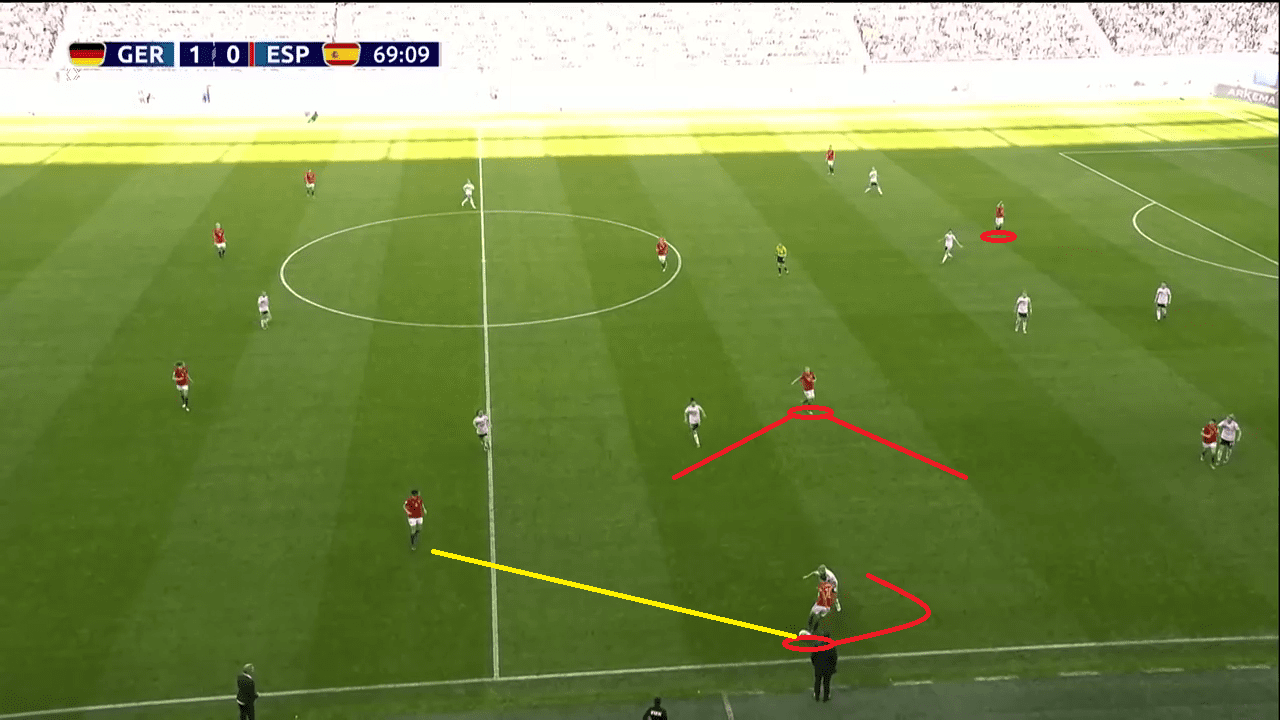
Frequently, the ball would be shifted to Jenni Hermoso, who would be showed wide by her German marker. However, with no options and her own path down the flank blocked off by defenders, she would turn back and still find herself with no option but to play the ball back. This is where Mariona Caldentey and Alexia Putellas needed to drop deeper to provide those options, making runs and allowing space for Nahikari García to make runs of her own with greater space between the full-backs. Instead, Silvia Meseguer and Virginia Torrecilla would offer more conservative sideways options rather than looking to break forwards with more offensive movements.
Germany got the ball in the danger area
Both sides registered a total of 13 shots, an impressive feat for Germany given their relative lack of possession. However, what was more impressive was their xG, registering 2.37 compared to just 0.33 for Spain. How that came about was the way in which Germany would look to rapidly get the ball forward with a more direct approach, and then look to get shots away as soon as the ball made it into the box. Rather than being content with a chance from distance, they would frequently look to cut inside or play in a cross into the danger area.
Without cover from midfield for Spain, their back four were unable to create a second bank to look to prevent the ball from being delivered in from deep or shared out wide. The result was clear, with Germany battering the Spanish goal.
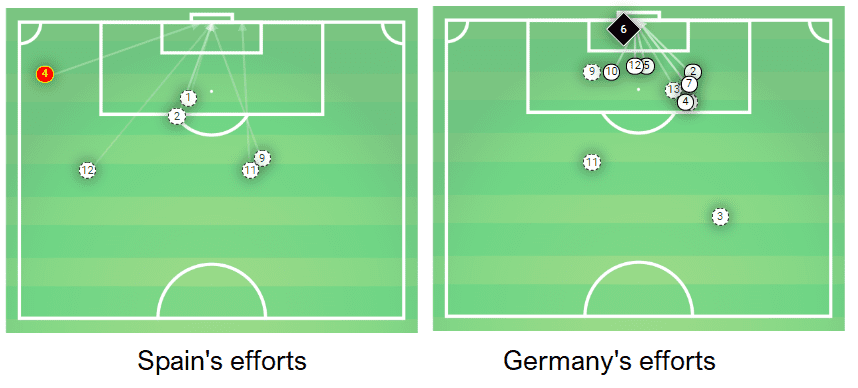
At the other end, Spain, overloaded with forwards cramping space in an already rigid set-up from the German defence, couldn’t find a way through. In total, they had just one shot from inside the box. In contrast, Germany had 10, including eight from closer to goal than Spain’s single one. Patricia Guijarro has built a reputation for her long-range strikes but coming on as a substitute in the 66th minute did not give her long enough to make an impact.
Conclusion
Germany showed their experience and clinicality in this fixture. Spain’s side remain a promising one, their ability to dominate a side of such quality showed as much, but it was their youth and inexperience which cost them. Unable to find a way through, they lacked the tactical solution to break down the German side and inevitably paid the price with defeat. For Germany, a second 1-0 win shows exactly what they’re good at: grinding out results. They can hope to go far in this tournament and whilst Spain have work to do, they should not be downbeat by this performance.
If you are following the FIFA Women’s World Cup 2019 then you will find our FREE tactical preview magazine the perfect compliment to the tournament. You can download it HERE – each nation is previewed and we also profile their key player and young player to watch. Enjoy!

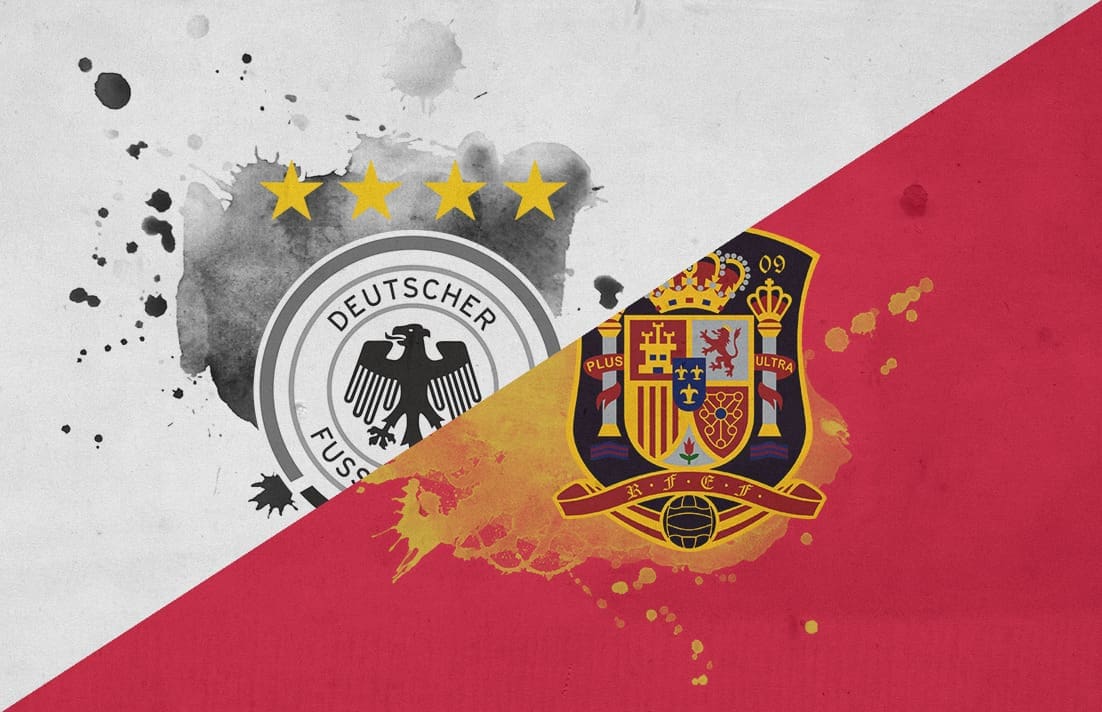



Comments